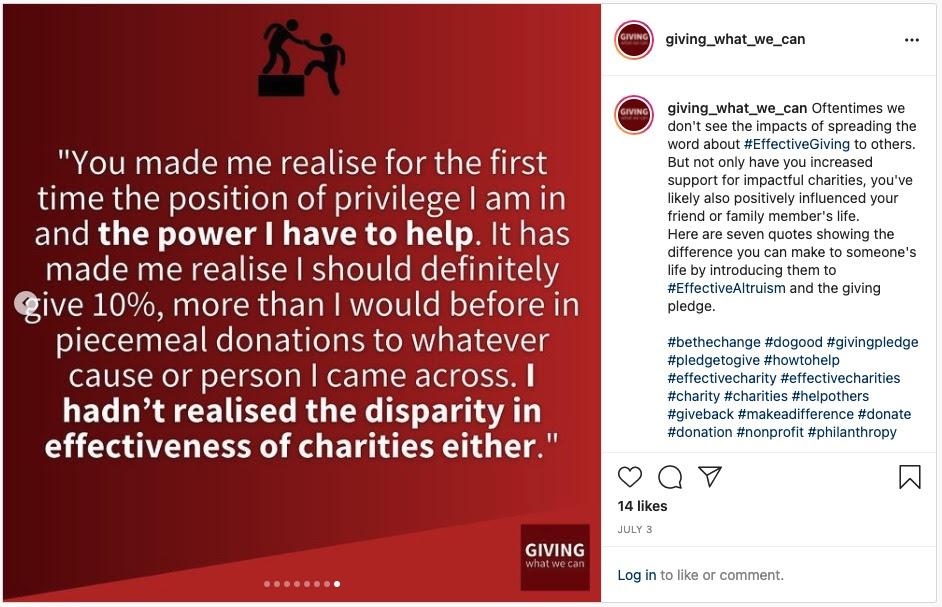Thanks to those of you who participated in our member motivations research! The results are in our latest report on why people pledge to give a meaningful portion of their incomes to effective charities.
We have further research to do, but at this stage, a few things seem pretty clear as motivators:
- People with means have an enormous opportunity to help others;
- They can have a much bigger impact if they donate effectively;
- Committing to act on this opportunity can help them to follow through on their plans to give; and
- Following through can help bring meaning and purpose to the lives of these committed effective givers.
This is exemplified by member Rickey Fukazawa who recently shared her effective giving story on our blog.
Sharing your effective giving story is a great way to inspire others to also give effectively.
We hope you enjoy the rest of this newsletter, which covers our upcoming online events, the latest from the effective altruism community, and news and updates about relevant cause areas.
Attend An Online Event
Come along and meet other people who are committed to effectively using their resources to improve the world:
- GWWC Online Meetup (Americas/Oceania):
Social meetup, 1-on-1s with members
August 7: 23:00 UTC - GWWC Online Meetup (Europe/Asia):
Social meetup, 1-on-1s with members
August 8: 09:30 UTC - Effective Giving Open Forum:
Ask anything, discuss donations, meet effective givers
August 18: 10:00 UTC
If you have any questions or want to discuss your donation decisions with other members or our team, we recommend registering for an Open Forum event. See all our events.
News & Updates
Effective altruism community
- 'The most successful EA podcast of all time' by Aaron Gertler, Centre for Effective Altruism
- EA Virtual Programs will now be run every month
- Vox's Future Perfect is hiring three full-time fellows for a one-year fellowship to cover topics of global importance
- 'You should write about your job' by Aaron Gertler, Centre for Effective Altruism
- 'What would you do if you had half a million dollars?' asks Patrick, winner of the $500k donor lottery
- 'Key Lessons From Social Movement History' by Jamie Harris, Sentience Institute
Evaluators and grantmakers
- Open Philanthropy is seeking proposals for outreach projects
- Open Philanthropy is hiring two roles in global health & wellbeing
- Animal Charity Evaluators have provided updates for their 2020 ACE Movement Grants recipients
Cause areas
Animal welfare
- 'Cultivated meat was once a vision, now it's becoming a reality' by Good Food Institute
- 'France bans killing day-old chicks, sparing 50 million chicks annually' by Reuters
- 'Bezos, Gates back fungus-based meat as next big alt-protein' by Bob Woods, CNBC
Global health & development:
- Against Malaria Foundation to fund 8.1 million nets for distribution in Nigeria in early 2022
- How to improve global health and wellbeing in clear and direct ways according to Alexander Berger from Open Philanthropy on the 80,000 Hours Podcast
- The World Health Organisation has certified China as malaria-free
- 'The world is making progress on clean water and sanitation, but is far behind its target to ensure universal access by 2030' by Hannah Ritchie, Our World in Data
Long-term future
- 'How to be a good ancestor' by Sigal Samuel, Vox
- Cold Takes blog has been launched by by Holden Karnofsky form Open Philanthropy. Some of the posts include: ''All Possible Views About Humanity's Future Are Wild', 'The Duplicator: Instant Cloning Would Make the World Economy Explode' and 'Digital People Would Be An Even Bigger Deal'
- Pressure mounts on UK Government to follow Welsh Government and back the Well-being of Future Generations Bill

Help Spread Effective Giving
A great way to multiply your impact is to tell people about effective giving. Here are just a few ways you can help advocate for effective giving:
- Share our giving recommendations.
- Update your profile picture on Facebook to include our photo frame.
- Frame your physical pledge certificate and put it on your wall, desk, or shelf.
Spreading effective ideas and growing our community helps us make progress on some of the world's most pressing problems. Importantly, it also enriches the lives of the givers. It can take courage, but it's worth it!
Useful Links
- Review our giving recommendations.
- Report your donations with your pledge dashboard.
- Share our ideas to help grow our community and multiply your impact.
- Join other members in the Giving What We Can community Facebook or LinkedIn groups.
- Find more ways to get involved with Giving What We Can and effective altruism.
- Discuss effective giving and effective altruism on the EA Forum.
You can follow us on Twitter, Facebook, LinkedIn, Instagram, or YouTube and subscribe to the EA Newsletter for more news and articles.
Do you have questions about the pledge, Giving What We Can, or effective altruism in general? Check out our FAQ page, or contact us directly.
